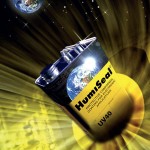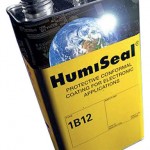An electronic product’s reliability has the potential to make or break its manufacturer and can be life-threatening in many safety critical applications. Conformal coatings have long been used to protect electronic assemblies from their operating environment but can vary hugely in their protective performance. HumiSeal has been a global manufacturer and supplier of conformal coatings since the late 1950s and today offers a range of over 60 coatings, thinners, strippers, masking and cleaning materials, as well as offering custom formulations to meet individual specifications. In this article the company looks at the top 10 most frequently asked questions relating to conformal coating and its application in order to dispel many of the uncertainties surrounding this area of manufacture.
What is conformal coating?
A conformal coating is a protective chemical coating or polymer film 25 to 75 µm thick (50 µm typical) that ‘conforms’ to the circuit board topology. Its purpose is to protect electronic circuits from harsh environments that may contain moisture and or chemical contaminants. By being electrically insulating, it maintains long-term surface insulation resistance (SIR) levels and thus ensures the operational integrity of the assembly. It also provides a barrier to air-borne contaminants from the operating environment, such as salt-spray, thus preventing corrosion. Some typical application examples include high-reliability defence, automotive and aerospace, where coatings are used to protect against various combinations of moisture, aggressive chemicals and vapours, salt sprays, large temperature variations, mechanical vibration, and even organic attack (e.g. fungus). The protective nature of conformal coatings also means that they not only protect, but also serve to enhance product reliability and thereby reduce the potential cost and damaging effects of early field failures. As such their use is becoming increasingly common in consumer and domestic applications that can be susceptible to environmentally-induced field failure; including portable devices comprising fine pitch, densely populated assemblies, such as mobile phones, through to washing machines.
How do you select the correct conformal coating?
There is no shortage of conformal coating materials, and the first thing to appreciate when selecting a conformal coating is that no perfect solution exists. To be able to effectively resist a variety of environmental attacks, many different formulations with widely differing performance characteristics have emerged. (Over the last 50 years, the HumiSeal range has grown to currently include over 60 different coating formulations to meet specific performance and process application requirements.) In reality, therefore, the performance of all conformal coatings should be regarded as a working trade-off. A gain in one parameter (for instance thermal resistance or thermal operating range) will inevitably be achieved at the expense of another (poorer salt or chemical resistance, for example). Choosing the right conformal coating and application process isn’t easy, and it’s safe to say that there is no such thing as a ‘perfect’ conformal coating product. There are five main types of conformal coating used in assembly, categorised by the primary solids material they contain: acrylics, polyurethanes (or urethanes), epoxies, silicones and UV curables. Each exhibits different strengths and weaknesses and the eventual operating environment of the assembly will ultimately govern the final choice.
Time and effort invested in getting it right can be amply rewarded by the near elimination of end product failures in the field. These failures and/or recalls can be the most expensive, reputation damaging and dangerous problems a company will ever experience. In short, if you have to conformally coat your boards, you have to get it right.
Understanding customers needs has led Humi-Seal to develop an industry first interactive selection tool on their web site (www.humiseal.com/product_selector). Users are able to enter environmental parameter requirements, in terms of operating temperatures, chemical resistance, cure time, VOC and approval requirements etc. Graphical icons represent the various chemistries and according to the values entered by the user, the product selector recommends the coating type that best matches the application. The selector is designed to make it extremely easy to use for anyone that may be unfamiliar with conformal coating. With this information in mind, the basic considerations to be addressed when selecting a suitable conformal coating are:
- Is the constant operating temperature over 150 °C? If the answer is yes then you should opt for either UV cure or silicone material groups.
- Does the coating need any form of chemical resistance? If chemical resistance is required then select either UV cure or polyurethane material groups.
- Is only moisture protection required? If yes then select either UV cure or acrylic material groups.
- What is the application method?
- What is the cure time available?
- Do you need Mil-Spec, IPC or UL qualification?
How do conformal coatings work?
A conformal coating is a protective barrier that shields sensitive electronic components against harsh environmental conditions such as moisture, chemicals and debris. They are not designed to be a total sealant. Conformal coatings are a breathable protective layer that will protect against the particular environment requirement but will also allow any moisture trapped in the circuit board to escape. The particular advantages of conformal coatings can be summarised as follows:
- Insulating properties allow a reduction in PCB conductor spacing of over 80 %
- Can help eliminate the need for complex, sophisticated enclosures
- Light weight
- Completely protect the assembly against chemical and corrosive attack
- Eliminate potential performance degradation due to environmental hazards
- Minimise environmental stress on a PCB assembly
Ideally, conformal coatings should exhibit the following characteristics:
- Simple application
- Easy removal, repair and replacement
- High flexibility
- Protection against thermal and mechanical shock
- Protection against environmental hazards including: moisture, chemicals and other corrosive elements
We are running a no clean, lead free production line, can I use conformal coating?
An important point to remember about conformal coatings is that they can trap contamination in as well as out so it is important to know what is on your circuit board before coating. In the case of a no-clean process it is a good idea to compatibility test the chosen coating with the solder paste and flux used during the manufacture of the board. Any respectable conformal coating manufacturers such as HumiSeal will provide this service and as a result we already have a considerable size matrix of cross compatibilities. In our experience we are finding that due to the higher activation levels and increased solids content of lead-free fluxes that there is an increase in chemical and physical incompatibility. Once tested you have a robust conformally coated no clean process.
How do you apply conformal coating?
To be effective, a conformal coating should completely cover the assembly and provide good coverage of sharp edges (components and component leads) and other contours (solder joints for example). It may even be essential to coat the edges of the board, as these will not even have any solder resist present. The effectiveness of the coating is, to some degree, influenced by the efficiency of the application method, which also governs the type of coating used (some suppliers offer dedicated versions of the same coating product to suit different application methods). There are essentially four main ways of applying a conformal coating:
- 1. Dipping – limited to materials that do not cure quickly by moisture, oxidation or light.
- 2. Selective robotic coating – such as Asymtek, PVA or DIMA. All coating types can be used if the correct dispense head is selected.
- 3. Spraying – hand spray using a spray booth or aerosol can. All coatings can be applied in this way.
- 4. Brushing – requires extremely proficient and skilled operators in order to be suitable for production purposes.
Finally you will have to consider the curing method determined by the coating selected, air dry, oven dry or UV light cure. The liquid coating should thoroughly wet all surfaces and cure without leaving surface defects. Epoxies are especially sensitive to surface defects. Epoxies can also shrink while setting and may lose adhesion as a result. In addition; excessive shrinking during cure can place severe mechanical stresses upon circuit components.
The supplier, to create the special formulation required for a particular application, should be able to modify all of these properties. Other characteristics can also be enhanced. Accessory chemicals and solvents should only be blended with base polymer resins by the coating manufacturer. Plasticisers can also improve mechanical flexibility, and selected solvents in conventional coating formulations can improve adhesion of the cured film.
How do I remove or repair conformal coating?
The coating should be easily re-workable (or repairable) so that solder touch-up can take place when components are replaced. In an ideal scenario the materials used for patching the coating should be of the same generic type as the original assembly coating itself. Additionally, the affected area must be cleaned (or more precisely, pretreated before re-coating. To fully answer this though we really need to consider each coating group individually:
- 1. Acrylics – These are probably the easiest coating to remove and repair. The coating can be removed completely or locally by using specifically designed stripping chemistries. The board can then be re-coated completely of just in area of the repair.
- 2. Polyurethanes – These coatings are slightly more difficult to remove due to their chemical resistance capabilities, however they can be removed by using specifically designed stripping chemistries. The board can then be re-coated completely or just in the area of the repair.
- 3. Silicone – This is the most difficult coating to remove and the coating least compatible with all of the other coating types. There are no solvents to remove silicone so it may only be removed by abrasion and this will leave silicone contamination on the board surface. Complete removal is virtually impossible so local repair is generally all that is attempted
- 4. UV cure – These materials are also more difficult to repair as they are the most chemically resistant and mechanically tough of all conformal coatings. Removal is possible locally by using powder abrasion. HumiSeal has developed a specific system for removal of our UV40 UV cure material. For local device replacement it is possible to melt through the UV40 coating to de-solder joints. After repair the board can be re coated and cured using short wave UV light.
Which conformal coating material is best suited to high volume manufacture?
Application and cure speed are the two factors important here and need to be considered carefully. For volume manufacture it is commonplace to use an in line robot selective coating system such as Asymtek, DIMA or PVA system. For high speed curing the most effective material would be a fast UV curing coating such as Humiseal UV40. This UV light cure material cures in seconds when in contact with short wave UV light. The curing is so fast that several coating systems can feed into one oven. UV40 is also 100 % solids and therefore VOC free so no high VOC output from production.
What standards do coatings have to conform to?
The physical characteristics of any conformal coating must meet strict minimal standards. The most commonly used are IPC-CC-830 (intended to supersede the old US military MIL-I-46058 spec – see later), IEC-1086, and UL approval. For a coating material to be ‘qualified’ to these standards, it has to meet (or ideally exceed) a plethora of detailed electrical and physical technical performance parameters. These include its dielectric constant, dielectric breakdown voltage, dielectric withstand voltage, insulation resistance, moisture insulation resistance, long-term hydrolytic stability, fungus resistance and continuous use temperature range (ºC). In addition to the mandatory requirements, the coating must have other properties to ensure it can be successfully suitable for use as a conformal coating. These other properties include Coefficient of Thermal Expansion (ppm/ºC), Young’s Modulus (MPa), Chemical Resistance, Ease of application and or rework and Convenient cure times, to name but a few.
There are basically five main coating standards and it is important to know which are required when selecting a suitable coating process.
• International (ISO/IEC) – IEC 1086 which relates to physical performance.
• National (UL, ASTM, BS) – UL 746E which relates to spark and burn issues.
• Government (MIL, DEF-Stan) – MIL-I-46085C which relates to quality and performance.
• Trade Association / Industry (IPC) – IPC-CC-830 which relates to quality and performance.
• Company (BMW, Bosch, Siemens etc) – Company designed specific tests.
How easily can conformal coating products be inspected?
Any conformal coating production process should be visually inspected in production under a UV light. All approved coatings contain a UV trace that glows with a bright blue luminescence under long wave UV light to make coated and uncoated areas easily detectable. With experience, operators can use the degree of luminescence as a measure of both presence and volume of coating at different locations across a board’s surface. The necessity for inspection becomes evident when one realizes that voids or bubbles can potentially provide a path for moisture to penetrate to the substrate. With automatic coating, a random or preselected interval test may be adequate, but 100 % inspection is always recommended, and is mandatory in high reliability and safety critical applications. There is a range of dedicated products available for this purpose. It is also important to inspect boards after rework to ensure any re-application of coating material doesn’t end up on the inside or underside of devices that should not be coated e.g. connectors.
How much coating will I use and what will the cost be?
This is obviously related to how many boards you process but there is a simple calculation that can give you a reasonably accurate prediction. Solvent based coatings should be applied at 50 µm dry thickness; UV coatings will be between 100 µm and 200 µm, depending on application method. The calculation is therefore as follows:
Volume per PCB (mL) = [width (mm) X length (mm) X dry thickness (mm) X 100 / %solid] / 1000
Cost per PCB (£/PCB) = [cost (£/L) X Volume per PCB (mL)] / 1000
Conclusion
As modern electronics assemblies continue to use ever greater packaging densities and reduced conductor widths and spacing, and are subjected to increasingly hostile operating conditions; the use of high performance conformal coating materials will become increasingly commonplace for virtually all manufacturers. Choosing the right conformal coating and application process isn’t easy. It therefore pays to work with a supplier that has the experience of solving hundreds of specific coating problems and can give advice on relevant reliability standards and specifications. Time and effort invested into getting it right will be amply rewarded by the near elimination of end-product failures in the field. These can be the most expensive, and in safety critical applications, life-threatening, problems a company will ever experience. In short, if you need to apply conformal coating to your boards, you must get it right. When you do this, you protect both your customers and your profits.
EPP Europe 420
Zusammenfassung
Den richtigen Schutzlack und Anwendungsprozess auszuwählen ist nicht einfach. Es zahlt sich daher aus, mit einem erfahrenen Lieferanten zusammen zu arbeiten, der bereits Hunderte von speziellen Schutzlackproblemen gelöst hat und zu entsprechenden Sicherheitsstandards und Spezifikationen Rat geben kann. Die Zeit und Mühe, die investiert wird, um es richtig zu machen, wird reichlich belohnt werden mit der fast vollständigen Beseitigung von Ausfällen beim Endprodukt im praktischen Einsatz.
Choisir le vernis protecteur et le processus d’application appropriés n’est pas simple. Il importe donc de travailler en collaboration avec un fournisseur expérimenté qui a déjà résolu des centaines de problèmes de vernis protecteurs spécifiques et qui peut donner des conseils sur les spécifications et les normes de sécurité correspondantes. Le temps et les efforts investis pour obtenir un bon résultat seront amplement récompensés grâce à l’élimination quasi totale des défauts du produit fini dans la pratique.
Non è semplice scegliere la vernice protettiva e processo applicativo corretti. Conviene quindi lavorare con un fornitore esperto, che ha già risolto centinaia di problemi specifici con la vernice protettiva e in grado di fornire consigli sugli standard di sicurezza e le specifiche. Il tempo e la fatica necessari per procedere correttamente saranno ricompensati dall’eliminazione praticamente totale dei difetti del prodotto finale nell’applicazione pratica.
Share:












